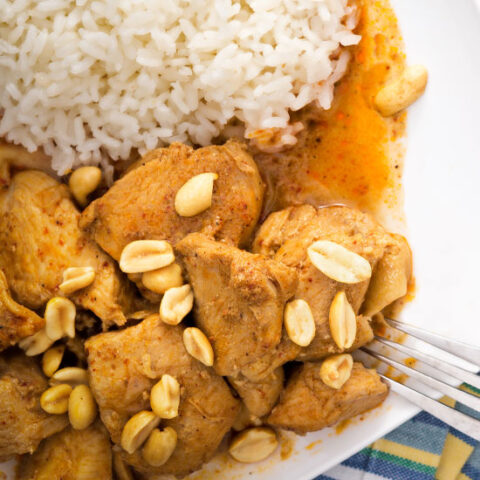Here’s a recipe for a low sodium Asian dish that is positively packed with flavor that you won’t miss the salt. This tasty low salt Thai-influenced dish comes together in about 30 minutes and the peanut sauce on this chicken is crazy good.
This dish is an easy way to change up your weeknight meal routine. Chicken breast browned in a hot skillet and then tossed in a delicious low salt peanut sauce. It’s easy, healthy, and definitely not your average chicken dinner.
I’m using boneless, skinless chicken breast for this recipe, but chicken thigh would work great as well. Tossing your chicken in a little cornstarch will help give your sauce a thicker texture on the palette. Most dishes like this utilize coconut milk, but there’s no milk here. The result is more sauce and less creamy. It is lighter and has more peanut flavor than a traditional Thai peanut chicken recipe.

Low Sodium Thai Peanut Chicken
Here’s a recipe for a low sodium Asian dish that is positively packed with flavor that you won’t miss the salt. This tasty low salt Thai-influenced dish comes together in about 30 minutes and the peanut sauce on this chicken is crazy good.
Ingredients
- 1/2 cup of a low sodium peanut butter
- 3/4 cup of water
- 2 tablespoons of balsamic vinegar
- 1 tablespoon of minced garlic
- 1 tablespoon of fresh lemon juice
- 1.5 pounds of boneless, skinless chicken breast, cut into 1" pieces
- 1 red bell pepper, diced
- 1 medium onion, diced
- 1/2 cup of unsalted peanuts, rough chopped
- 1 1/2 cup of carrots, finely chopped
- 1/2 teaspoon of crushed red pepper flakes, optional
- 1 tablespoon of olive oil
Instructions
- In a small mixing bowl, whisk together the peanut butter, balsamic vinegar, garlic, lemon juice, and water until fully blended to create your sauce. Set aside.
- In a sauté pan, cook the vegetables in olive oil until translucent, and remove from the pan and set aside.
- Using the same sauté pan, cook the chicken and peanuts in the oil until the chicken is cooked through. Remember to flip your pieces of chicken so each side gets a nice brown sear.
- While you are cooking your chicken, start preparing your side dish of choice by boiling your rice or pasta.
- When the chicken has reached an internal temperature of 165 degrees, add your vegetables and peanut sauce to the pan. Let simmer over medium-low heat for 10-15 minutes, stirring occasionally.
- Plate your Thai peanut chicken with your rice (or pasta) and dust the finished dish with red pepper flakes and chopped peanuts.
Notes
- I typically serve this with a side of jasmine or basmati rice but this dish is excellent with pasta. Use the noodle of your choice; a long fettuccini noodle, a bow tie pasta, egg noodles, even macaroni noodles are all great choices. Remember, do not rinse your pasta! Doing so will wash away all the starch which is what makes your sauce cling to your pasta.
- How much rice per person? Typically you should plan for about 1 cup of cooked rice per person. This equates to 1/2 cup of uncooked rice as rice doubles in size upon cooking.
- Occasionally I like to add broccoli to this dish. I find the tasty low sodium peanut sauce gets trapped in the broccoli making for a delicious treat.
Recommended Products
As an Amazon Associate, I earn from qualifying purchases. For complete information please read the disclosures page (link at the bottom of this page).
Nutrition Information
Yield 4 Serving Size 1 Amount Per Serving Calories 847Total Fat 51gSaturated Fat 10gTrans Fat 0gUnsaturated Fat 34gCholesterol 145mgSodium 273mgCarbohydrates 31gFiber 8gSugar 11gProtein 73gNutritional information is provided as an estimate. Nutritional content may vary due to several factors such as how much of an ingredient is used vs. how much will actually be eaten, brand differences, and more. To ensure the most accurate nutritional information, the reader should make calculations based on the ingredients actually used, using their own preferred method, or consulting with a licensed nutritional expert. This Website is not intended as a source of nutritional or food safety advice, and its readers assume full responsibility for any decisions made regarding their own health and safety. Nutritional information calculated by Nutritionix


